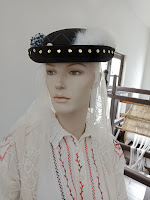#08
Associated with the typical costumes are several accessories, in this exhibition placed purposely in focus: shawls, handkerchiefs, bags for carrying personal belongings, pocketbooks.
When wearing a typical garment, it is standard to wear a pocket around the waist, which can vary in size, cut, shape, and decoration, showing or not a small white handkerchief with a pointed tip on the outside; the decoration is done with beads, glass beads, ribbons, and wool embroidery.The wearing on the waist of a lover's handkerchief or a request handkerchief, testifying the art of embroidery and the will to seduce becomes almost mandatory in the dynamics of a folkloric group. This scarf can also be seen on men's necks, revealing the amorous commitment to the woman possessing it. In this exhibition four examples are presented, in protective and exhibition frames, three of them embroidered in free stitch and another in cross-stitch, in red. The poetics of the handkerchiefs demonstrate the interest of loving communication and the values of property and family, in symbols and marks. The red handkerchief was embroidered by Sílvia Malheiro, an embroiderer of singular scope and exquisite execution details, it belonged to the deceased Cecília de Melo, a member of this Association.
This exhibition presents a Valentine's handkerchief, made in the form of a wall tapestry, projecting it as a form of decorative art. This work was conceived by José Machado and produced by the group's elements.
The whole costume is accompanied, in principle, by a piece of clothing, in this case the wool shawl, suspended from the arm. If there is a long cape, it goes over the back, covering the whole costume.
The use of gold pieces to adorn the neck, chest, and hands is done according to the taste of each owner or trustworthy of others. Ourar is, in folklore, a treatise of personal passion and pride. The economics of ourar is a philosophy of life. It is natural and derives from the sense of saving and making personal and family patrimony, for a woman to own some earrings or rings, to have a gold chain, a piece, a braid, a rack, some pins, some pounds or half pounds, a butterfly, some hearts, some crosses, a reliquary, rings and bracelets...
But, in this exhibition, the pieces that "imitate" the function of weaving are A. P. GALERIA's resources, and are for sale in the store, and can be purchased.
Presented is a piece produced on a loom, the king's crown, an iconic piece in Minho folklore. It translates the long duration of the royal imaginary and its presence in the material patrimony of many houses and monuments, tablecloths, bedspreads, flags, stones, pictures, etc. This form is often used to embroider it in cross-stitch in the center of a lover's handkerchief, or to embroider it in flower-stitch on the back of a man's vest, or to embroider it in glass beads in the center of a woman's apron.
The slippers can be stitched in white and assume configurations according to the taste of the one who orders them to be made and the one who makes them. Other forms of footwear, namely connected to more functional forms of dress or cotio, occur on both men and women: boots, clogs and clogs, chancas, shoes, slippers.
The hat industry in Braga had a name and unquestionable merits, lasting in the imagination and in certain commercial houses. The decoration of this exhibition, using a creative fantasy around the hats, intends to honor the memories of the industry and the popular sayings related to the hat:The good head, never lacked a hat.
There are many hats...
Lend me your hat, Antoninho, my love.














